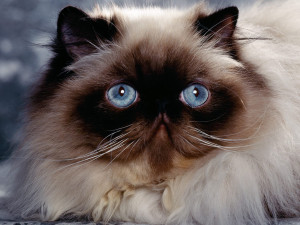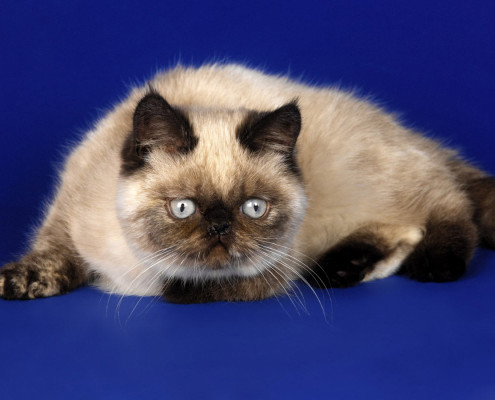Himalayan/Colorpoint Persian

Meoww!!
A lovable cat, the Himalayan can be both a quiet companion and energetic playmate. This breed is generally friendly to everyone.
In 5 Words
- Longhair
- Intelligent
- Lovable
- Energetic
- Friendly
Snapshot
WEIGHT RANGE:
Male: large: >12 lbs.
Female: medium: 8-12 lbs.
EYE COLOR:
Blue, Copper, Green
EXPECTATIONS:
Longevity Range: 8-11 yrs.
Social/Attention Needs: Moderate
Tendency to Shed: High
COAT:
Length: Long
Characteristics: Straight
Colors: Chocolate, Seal, Lilac, Blue, Black, Flame, Red, Cream, Tortoiseshell, Frost, Silver, Golden, Brown, Fawn, Cinnamon
Less Allergenic: No
Overall Grooming Needs: High
CLUB RECOGNITION:
Cat Association Recognition:
ACFA , FIFe, TICA
Prevalence: Common

Characteristics
Learn About the Himalayan/Colorpoint Persian
The history of the Persian is filled with romantic images of dusty desert caravans, rare spices on camels and the most precious cargo, an occasional longhair cat. They were called Persian for their “country of origin,” but there is references in hieroglypics as early as 1684 B.C. In England, Brian Sterling-Webb perfected his long-haired colorpoint over a period of 10 years. In 1955 he approached the Governing Council of the Cat Fancy (GCCF) and requested recognition for this new variety of longhaired cat. Since he and other breeders were prepared to describe and defend the work that had gone into the development of this new color, recognition was granted and the Longhaired Colourpoint was accepted as a breed in England.. The Himalayan is basically a color-pointed Persian and is still known in Great Britain as the Color-Pointed Longhair. It was actively developed starting in the 1920s by selective crossings of pedigreed Persians with Siamese, with the goal being to produce a thoroughly Persian cat in terms of temperament and type, but with the dramatic color-point markings of the Siamese. Dr. Tjebbes, a Swedish geneticist, was involved in some of these early experimental breedings as part of a research study.They were bred from Siamese (for the markings) and Persians (for coat-length and temperament), and share the characteristics of both breeds. Himalayans are now considered the same breed for cat registries (CFA), (TICA) as the modern Persian show cat since they have the exact same conformation with a pointed coat.
Sometime in the mid-1930s, a particular Black Persian reportedly was crossed with a Siamese, producing three black, short-haired kittens. Two of those kittens eventually were mated together, producing a long-haired female named Debutante. When she reached maturity, Debutante was bred back to her father, and a long-haired, pointed Persian was the result.
The Himalayan cat’s body is medium to large, of the “cobby” type, low on the legs, broad and deep through the chest, equally massive across the shoulders and rump, and with a sweet “pansy” face. Contrary to its “fluffy” appearance, the Himalayan cat has good muscle tone with no evidence of obesity.The head is large, round, and smoothed domed with great breadth of skull that is set on a short, thick neck.They have a well developed chin.They have overall round appearence.Tail is short and thick.The nose is short and ears are small and round at tip.
Persians, with their long flowing coats and open pansy-like faces are the number one breed in popularity. Their sweet, gentle, personalities blend into most households once they feel secure in their new environment. Creatures of habit, they are most at home in an atmosphere of security and serenity, but with love and reassurance, can easily adapt to the most boisterous of households. For the most part the Himalayan is not a hyperactive cat; that is to say, they are not moving all the time. They like to play and they are active. As one of the most popular of all domesticated cat breeds, Himalayans – like other color varieties of Persians – are extremely affectionate, loving and loyal. They are sweet, gentle, relaxed cats, who prefer to be in familiar, secure surroundings.The Himalayan can be playful, but spends most of its time supervising its people and making sure all in the household is in order. This lap cat forms very close bonds with its owners.
Due to their Persian ancestry, some Himalayans may have the gene that causes Polycystic kidney disease, (PKD), but a genetic test can reveal which cats carry the PKD gene, so that they may be spayed or neutered.Himalayans reportedly have an increased risk of developing basal cell tumors, corneal sequestration and hyperaesthesia syndrome. They also are prone to developing calcium oxalate urolithiasis, which are a particular type of urinary tract stones. Hairballs are rarely serious, but they can cause discomfort, vomiting, and diarrhea in otherwise-healthy cats.
He needs regular baths to stay clean and sweet-smelling. Introduce a kitten to bathing as soon as you bring him home and he will accept it readily. Some Himalayans have a problem with excessive tearing of the eyes. To prevent ugly staining, wash the cat’s face daily, particularly beneath the eyes.The rest is basic care. Trim the nails as needed, usually weekly. Check the ears every week for redness or a bad smell that could indicate an infection. If the ears look dirty, wipe them out with a cotton ball dampened with a gentle cleanser recommended by your veterinarian. Brush the teeth frequently with a vet-approved pet toothpaste for good overall health and fresh breath. Start brushing, nail trimming and teeth brushing early so your kitten becomes accepting of this activity.






